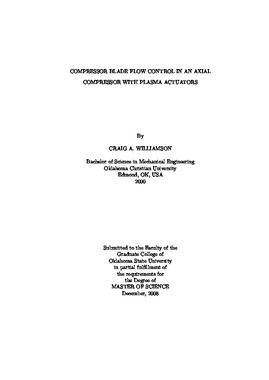| dc.contributor.author | Williamson, Craig A. | |
| dc.date.accessioned | 2014-04-17T19:54:21Z | |
| dc.date.available | 2014-04-17T19:54:21Z | |
| dc.date.issued | 2008-12-01 | |
| dc.identifier.uri | https://hdl.handle.net/11244/10088 | |
| dc.description.abstract | Flow control in an axial compressor using plasma actuators was investigated. A plasma actuator was mounted on blades in a rotating compressor cascade and its effects on the flow were observed via wake measurements. Prior to the blade study, two configurations of a plasma actuator were examined in the quiescent state using particle image velocimetry (PIV) with either Teflon or Kapton as the dielectric material. The velocity profiles for the Kapton and Teflon dielectrics with steady plasma actuation showed that the Kapton configuration only produced a maximum velocity of about 5 cm/s while the Teflon configuration produced a maximum velocity of about 40 cm/s. Pulsing the actuators for the same arrangement with a forcing frequency of 50 Hz displayed maximum velocities of about 3 cm/s and 9 cm/s on the Kapton and Teflon configurations, respectively. Momentum calculations performed on the two actuator configurations and an average compressor rotor blade wake show that the Teflon actuator momentum input was approximately 1% of the blade wake momentum deficit. The Teflon configured actuator was installed on one blade in a single stage axial compressor and blade wakes were measured in the laboratory reference frame using a hot-wire anemometer. Blade wake momentum calculations were made on the compressor rotor in response to various plasma actuator and compressor operating conditions. Both leading edge and 1/4 chord plasma actuator configurations were examined in the counter and co-flow directions. The blade wake of the rotor was measured using a hot-wire at blade Reynolds numbers of 170,000 and 260,000. The compressor rotor momentum calculations showed that leading edge actuation can have an unpredictable effect and may cause an increase in drag. The best case observed was at steady actuation for a Reynolds number of 170,000 and at a forcing frequency of 50 Hz for a Reynolds number of 260,000. The counter flow actuator orientation at 1/4 chord showed less control than over the co-flow case. The maximum drag decrease was seen at a Reynolds number of 170,000 and a forcing frequency of 50 Hz. | |
| dc.format | application/pdf | |
| dc.language | en_US | |
| dc.publisher | Oklahoma State University | |
| dc.rights | Copyright is held by the author who has granted the Oklahoma State University Library the non-exclusive right to share this material in its institutional repository. Contact Digital Library Services at lib-dls@okstate.edu or 405-744-9161 for the permission policy on the use, reproduction or distribution of this material. | |
| dc.title | Compressor Blade Flow Control in an Axial Compressor with Plasma Actuators | |
| dc.type | text | |
| osu.filename | Williamson_okstate_0664M_10107.pdf | |
| osu.college | Engineering, Architecture, and Technology | |
| osu.accesstype | Open Access | |
| dc.description.department | Mechanical & Aerospace Engineering | |
| dc.type.genre | Thesis | |
